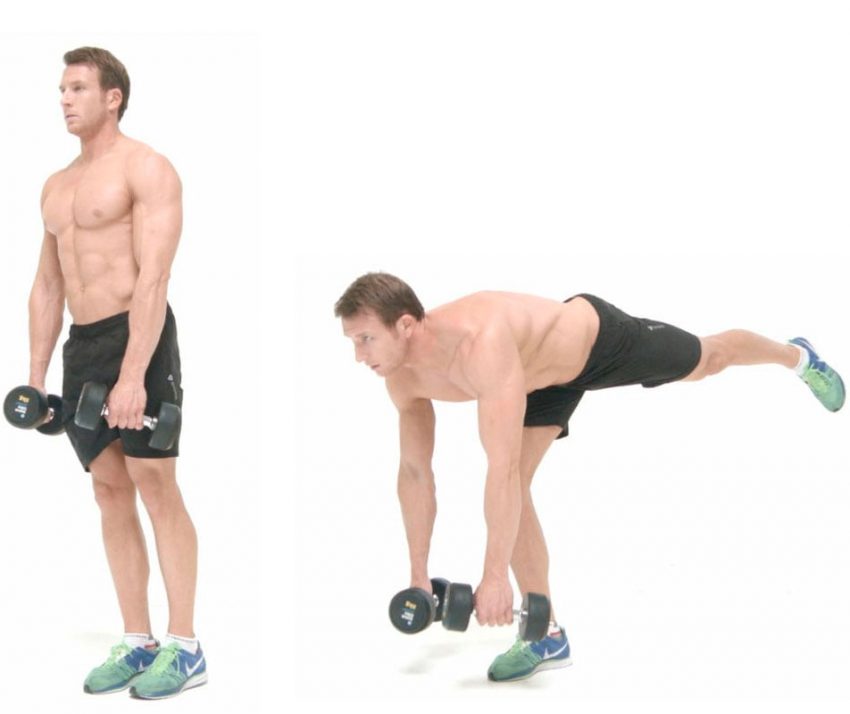The Romanian deadlift on one leg is an exercise that came into fitness from the physical training of athletes. In running, it serves to “level out” the stride length of the runner. In fitness, it helps to achieve symmetry when pumping up the muscles of the buttocks. The Romanian Single Leg Deadlift is an exercise that develops balance and strength and is available to athletes of all levels. Beginners can start with no weight and continue with small dumbbells. Movement requires skill, but can be mastered by almost everyone.
The benefits and disadvantages of exercise

If the usual “Romanian” is a movement on the hamstrings and gluteus muscles, which is simply intended for their development, then the Romanian deadlift on one leg allows you to use stabilizing muscles that hold the core in the right position and prevent it from collapsing during the exercise … This allows the exercise to be a good preparatory step for any complex movement.
The benefits of this exercise are as follows:
- May help develop strength if one half of the body is lagging behind;
- Strengthens not only the hamstrings and buttocks, but also the core;
- Improves coordination of movements;
- Prevents running injuries;
- Allows you not to overload the spine;
- Suitable for both power and multi-repetition work;
- Helps to build a symmetrical physique, firm glutes, and slender thighs;
- Promotes the concentration of the load in the gluteal muscles and hamstrings.
The main disadvantage of this exercise is that it requires good coordination and is technically more difficult than its “two-legged” versions. In addition, some people may feel uncomfortable doing it due to the skewed pelvis. They should avoid using this movement in their training plan when it comes to variation with weights, and only perform it without weight.
Dumbbell technique

You can perform the movement with one or two dumbbells, with or without a platform. Some people with long legs are comfortable doing the exercise from a step platform or other platform. Support is also needed for those who naturally have high mobility in the hip joint.
Technically, the exercise is done like this:
- You need to stand up straight, grab the dumbbells with a straight grip and transfer the weight to one leg;
- The free leg comes off the platform, the knee can remain straight or slightly bent;
- Only hip flexion and forward bend should be performed;
- When standing up – reverse movement in the hip joint;
- The free leg can be straight at the knee joint if comfortable;
- The exercise is performed first on one side, then on the other.
There are several variations of this movement:
- With one dumbbell, which is located in the hand of the same name;
- Cross with one dumbbell;
- With two dumbbells;
- With alternating leg raises
- Variations allow you to use your core muscles differently, but not your hamstrings, they are loaded in about the same way.
A variation with one dumbbell is considered good for working out the press, with two – more suitable for strength and mass, since you can take heavier weight.
Options for different types of halls

Classic – with the leg back. This option is used in all cases when it is necessary to perform an exercise and there are conditions for this, for example, free weights and free space. The option suits those. Who doesn’t have a problem with coordination:
Platform – This variation does not require a leg back and hip extension. Normal work without abduction is enough, the non-working leg is de-weighted;
Work with placing your feet on a chair or gymnastic bench. The free leg is placed with the ankle joint on the chair, the forward bend is performed and the exercise in steel resembles a regular traction
Barbell technique

- The barbell is taken from the floor, using the usual deadlift technique – the legs are bent at the knees, the barbell touches the floor, the body is lowered to the floor, and then unbend. Then the non-working leg is outweighed, and the usual flexion in the hip joint occurs, and the barbell slides to the middle of the lower leg, in the opposite order, straightening occurs;
- The required number of repetitions is performed with one leg, and then the leg changes and work occurs with the other;
- It is important to take the barbell symmetrically on both sides.
Smith Machine Technique

A convenient option for beginners, for “finishing” and those who do not need to develop balance and it will be enough just to perform the exercise on the buttocks and hamstrings in isolation
- This is a simpler exercise compared to barbell bends. The movement takes place strictly in the hip joint;
- It is easy to maintain balance, you just need to stand in the center of the simulator, and not move to the sides;
- The movement is a normal forward bend, produced by flexion at the hip joint. The knees of the working leg are slightly bent, the free knees are straight;
- It is important not to pull the bar with your hands, so you need to use a substantial amount of weight for the exercise to be performed correctly.
